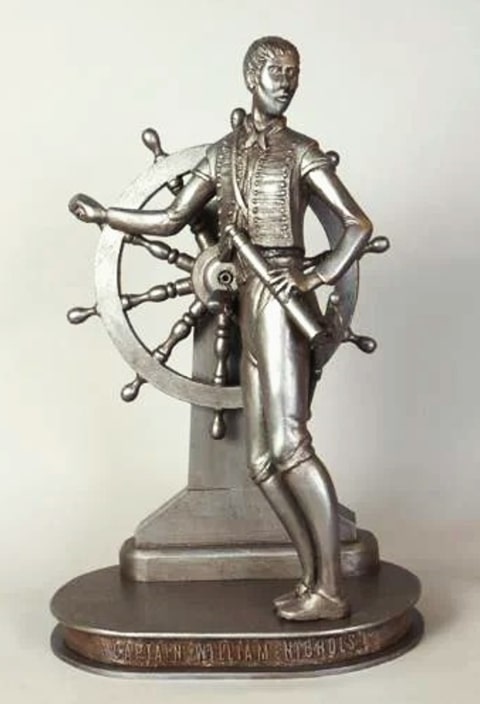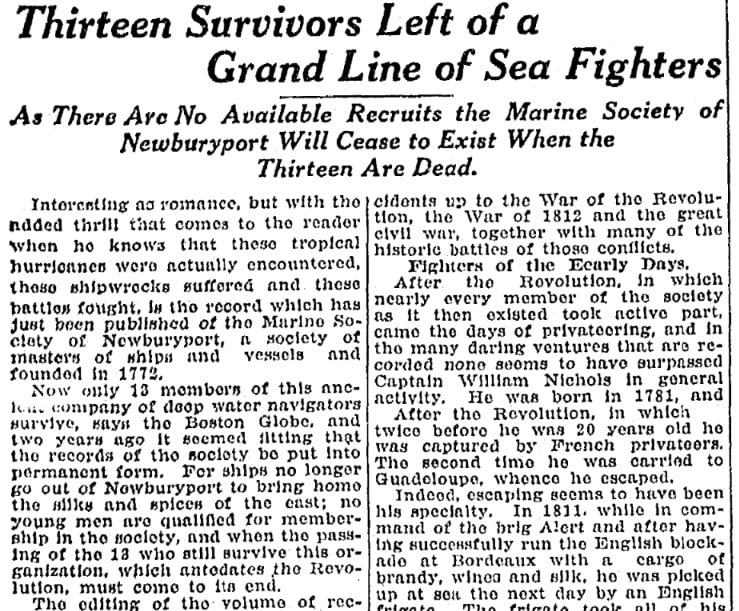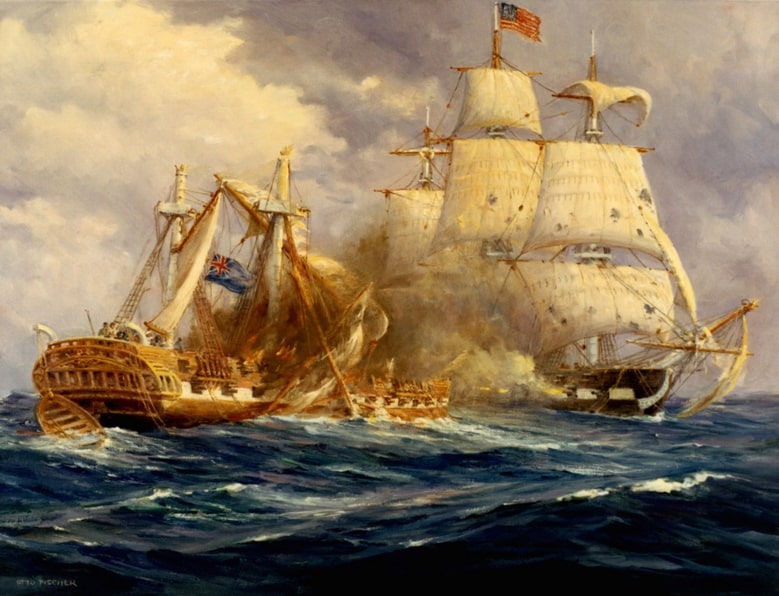Introduction: In this article – the second of three parts – Melissa Davenport Berry writes about a bold and successful privateer who raided British shipping and helped the U.S. greatly in the War of 1812. Melissa is a genealogist who has a website, americana-archives.com, and a Facebook group, New England Family Genealogy and History.
Today I continue with my story of Newburyport, Massachusetts, champion privateer Captain William Nichols (1781-1863), known to surpass in glory all the maritime legends. During the War of 1812, locals called him “fearless,” and the Brits dubbed him the “Holy Terror.”

To recap: In part one I introduced the War of 1812 and some early history of Capt. Nichols. The War of 1812, between the United States and the United Kingdom, was fought on land and water. Since the British had the world’s largest navy, the U.S. supplemented its much smaller navy by enlisting the aid of privateers – private ships that raided the enemy’s commercial shipping, committing acts authorized in wartime that would have been considered piracy during peacetime.
Captain Nichols was born to Revolutionary War hero Capt. William Nichols Sr., and Mary “Polly” Batchelder. He married Lydia Balch Pierce and left descendants. The annuals reveal Nichols emulated his father’s courage and dare-devil nature.
Both Nichols men were members of a sacred brotherhood. Newburyport once harbored an ancient company of seafaring nobles known as the Marine Society. They were the grand lines of merchants, master mariners, and privateers who battled ferocious enemies and treacherous seas.
They and their ships that once brought exotic wares from the East and prized, captured cargo from enemy vessels, are no more.
However, Capt. Nichols has been resurrected from the magical waters.
First, Dr. G. William Freeman, a sixth-generation descendant of Nichols, has furnished the riveting tales of the privateer in his book The Holy Terror: The True Story of Captain William Nichols. Second, the renowned sculptor Jeffrey Briggs fashioned a likeness of Nichols for the April 2023 exhibit “Legendary Newburyporters,” honoring the “movers and shakers” of Clipper City.

When the history of the Maritime Society was published in 1906, only a few of the old sea dogs were still around.
The Kalamazoo Gazette published an article entitled “Thirteen Survivors Left of a Grand Line of Sea Fighters,” and asserted that of all the members of the Marine Society, “none seems to have surpassed Captain William Nichols in general activity.”

This article reported:
He was born in 1781, and twice before he was 20 years old he [Nichols] was captured by French privateers. The second time he was carried to Guadeloupe, whence he escaped.
Indeed, escaping seems to have been his specialty. In 1811, while in command of the brig Alert and after having successfully run the English blockade at Bordeaux with a cargo of brandy, wines, and silk, he was picked up at sea the next day by an English frigate. The frigate took all of his crew except the mate and two boys, put a prize crew on board, and ordered the vessel to Plymouth, England.
That same day, it is recorded, “he retook the vessel by his own individual efforts, surprising the watch on deck, the officers in the cabin, and the sailors in the forecastle. The prisoners he put in the ship’s boats and headed them for the coast of France.”
The article further reported that a week later, Nichols was again captured, this time by the British frigate Vestal. He tried to plead his way out by telling them he had previously been taken, but that did not matter, and the Englishmen took Nichols to Portsmouth and put him on a prison ship. When he was brought ashore for trial he escaped. Hold onto your seat as I recap this tale:
Nichols made his getaway, as sources tell us, by traversing gardens and leaping hedges, and then he hopped a coach to London and bumped into the very sergeant he had just busted away from!
Nichols responded to his opponent: “Here are three guineas you can have, but never me!” Luckily, the sergeant favored coin and Nichols went free.
Nichols made his way to Liverpool, where he embarked on the Alpha for Philadelphia, and then the Nancy to Newburyport. Capt. Charles M. Coffin of Nantucket was on board the Alpha with him.
Capt. Coffin was not the only interesting chap Nichols encountered onboard. One-time vice-president (and antagonist in the infamous duel with Alexander Hamilton) Aaron Burr was also a passenger, under the alias Adolphus R. Arnot.
The article explained that:
He no sooner returned to Newburyport than war began with England, and he was given command of the privateer Decatur, carrying 14 guns and 150 men.
Leaving port on 4 August 1812, the Decatur sailed out to make history. Nichols’ first close encounter ended without harm; the Decatur was chased for two hours by a warship Nichols thought was the enemy, during which he threw overboard 12 of his 14 guns in order to lighten the ship and out-run his pursuer.
When the other ship finally caught up with them, Nichols suspected the Decatur would become a prize. However, he was pleased to find Captain Isaac Hull (later Commodore) wearing an American naval uniform – the ship was the famous quick-fire U.S. Navy frigate Constitution.

Nichols tipped Hull off that the Brit frigate Guerriere had given him chase the day before – the very vessel Hull was in hot pursuit of.
The next day, thanks to Nichols’ tip, the Constitution found and defeated the Guerriere, and the legend of “Old Ironsides” was born. Capt. Nichols’ contribution to that battle should never be overlooked.
To be continued…
Explore over 330 years of newspapers and historical records in GenealogyBank. Discover your family story! Start a 7-Day Free Trial
Note on the header image: close-up from a portrait of Captain William Nichols, attributed to Charles Delin. Courtesy of Museum of Old Newbury, Newburyport, Massachusetts.
Related Article:
